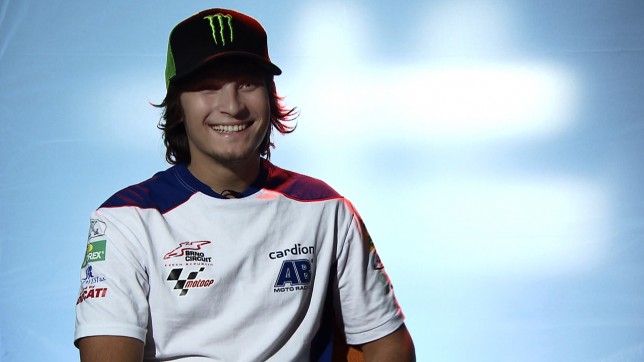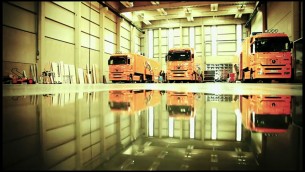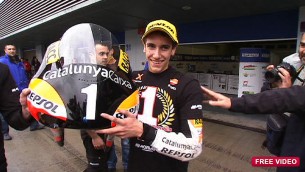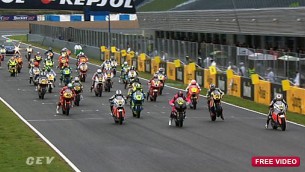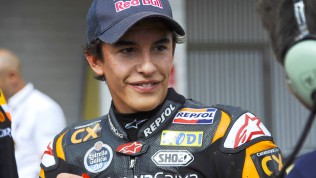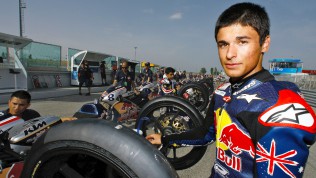MotoGP is the premier motorcycle racing World Championship; an eighteen-race series visiting fourteen countries, four continents and with pan-global television coverage. Eight nationalities of the world’s most skilled riders line a grid armed with cutting-edge motorcycle technology with prototype machinery fielded by four manufacturers; Ducati, Yamaha, Honda and Suzuki.
Established as a World Championship by the FIM (Fédération Internationale de Motocyclisme) in 1949, MotoGP is now into its 63rd year. It is the oldest motorsports championship in the world and the premier class of three racing classes that take to the track on a typical Grand Prix weekend. Formerly labelled ‘500cc’, the championship underwent a change in 2002 with new technical regulations permitting the introduction of four-stroke machinery and increasing the engine capacity to 990cc, thus becoming MotoGP. From 2007 the rules were again altered, limiting engine capacity to 800cc. MotoGP has been administrated by commercial rights owners Dorna Sports under the supervision of the FIM since 1992.
MotoGP has a rich history with Grand Prix events having taken place in every corner of the world throughout the last 62 years. More than 2.2 million people came through the gates of the circuits to watch MotoGP in 2010. Italy, Great Britain, Spain, the USA and Australia are just some of the nationalities that have all totalled high numbers in terms of race victories and world titles, the details of which can be found in the Results & Statistics section.
As well as the premier class there are also two ultra-competitive World Championship Grand Prix categories which form part of ‘MotoGP’. The 125cc and Moto2 (formerly 250cc) World Championships have their own races at each Grand Prix, meaning that by the end of the season three new champions are crowned.
RACE WEEKENDS
On a Grand Prix weekend there is a race in each of MotoGP’s three categories:
125cc – Is the first step for young riders into World Championship competition. Maximum engine displacement is 125cc (single-cylinder units). The maximum age for riders is 28 years (25 for wild-card riders or those newly contracted and competing in a 125cc GP for the first time) and the minimum age is 16 years.
Moto2 – This new 4-stroke class was announced in December 2008 and replaced the 250cc category from 2010. Moto2 is aimed as being a prestigious yet cost-effective accompaniment to the premier class of MotoGP. Honda is the sole engine supplier, and Dunlop provide the tyres. The bikes are powered by a 600cc 4-stroke engine, producing around 140hp, and the Moto2 class continues the 250cc series’ pursuit of developmental excellence with the running of a prototype chassis which is free from limitation. The design and construction of the chassis is free within the constraints of the FIM Grand Prix Technical Regulations. The main frame, swingarm, fuel tank, seat and fairing/bodywork from a non-prototype (ie. series production road-homologated) motorcycle may not be used. The minimum age for riders is 16.
MotoGP – The ultimate test for the finest talents in motorcycle racing, in which the maximum engine capacity is the aforementioned 800cc (4-stroke engines) and the minimum age for riders is 18. Motorcycles competing in the MotoGP class must be prototypes.
At selected events the race timetable is augmented further by the Red Bull MotoGP Rookies Cup – an initiative designed to unearth future MotoGP stars from across the world.
A Grand Prix event takes place over three days, with the first two of those for practice and qualification for each class. The third day is race-day. There are free practice sessions on Friday and Saturday, and a single qualification practice on Saturday afternoon then determines grid order for Sunday's race, with the fastest riders taking the front slots. In each category the three fastest riders take positions on the first row of the grid, with the rest lining up in rows of three behind.
After warm-up sessions for each category on race-day, traditionally the 125cc contest begins the programme, with the Moto2 class following and then finally the blue riband MotoGP event. This can be subject to change however. Races vary in length between 95-130km and normally last between 40-45 minutes, conforming to a set number of laps which differs at each track. Pit-stops are rare but permitted, and are especially applicable in changeable weather conditions when riders can enter the pit-lane and switch machines to one fitted with different spec tyres (only MotoGP).
RIDERS
The current MotoGP World Champion is factory Yamaha rider Jorge Lorenzo, who in 2010 claimed his first premier class title. The Championship saw Dani Pedrosa (Repsol Honda) finish runner-up behind him after some fantastic battles along the way, with nine-time World Champion Valentino Rossi placing third.
Meanwhile, the likes of Honda rider Casey Stoner (2007 MotoGP World Champion) and Repsol Honda’s Andrea Dovizioso are also stars of the show, with riders such as Colin Edwards, Nicky Hayden and Ben Spies all challenging for top-five finishes. In 2011 they will be joined by a selection of new riders – known as Rookies – who will ensure that the level of competition and racing ability remains at an exceptionally high level. Czech rider Karel Abraham moves up from the Moto2 class and Brit Cal Crutchlow arrives from World Superbike, with 2010 Moto2 Champion Toni Elías making a return to the elite category.
The list of participants in each Grand Prix is composed of the permanent riders, contracted and nominated by their teams for the whole season, and wildcard entries – who are often local riders. Approximately 18 participants enter each MotoGP race, about 40 take part in each Moto2 race and the 125cc races usually involve around 30 riders.
Riders from around the globe take part in the World Championships including the following countries: Australia, Austria, Colombia, Portugal, Czech Republic, Finland, France, Germany, India, Italy, Japan, Malaysia, the Netherlands, Norway, Qatar, Russia, San Marino, Spain, Switzerland, Thailand, UK, USA and Venezuela..
For profiles of every rider from all three Grand Prix categories visit our dedicated Riders & Teams section.
MotoGP also has close links with the Riders for Health charity, which helps health workers in Africa have access to reliable transportation so they can reach the most isolated people with regular and predictable health care.
Minggu, 27 November 2011
Rabu, 23 November 2011
MotoGP motogp.com FIM Language: ENG| ESP| ITA| 日本語| FRA| DEU| POR motogp.com RSS Videos Buy VideoPass Latest Videos Seasons Riders Teams Free Videos Classics No Spoiler News Latest news Riders Teams Photos Latest photos Seasons Paddock Girls Riders Teams Features Glossary Workshop Inside MotoGP My First Team Profile Paddock People Remember Special Riders & Teams MotoGP riders MotoGP teams Moto2 riders Moto2 teams 125 riders 125 teams MotoGP Legends Results Latest results Statistics Calendar 2012 Calendar 1 - Qatar 2 - Spain 3 - Portugal 4 - France 5 - Catalunya 6 - Great Britain 7 - Netherlands 8 - Italy 9 - Germany 10 - United States 11 - Czech Republic 12 - Indianapolis 13 - San Marino 14 - Aragon 15 - Japan 16 - Australia 17 - Malaysia 18 - Valencia Inside MotoGP MotoGP Basics MotoGP in the Media Riders for Health Sponsors VIP VILLAGE Safe and green Fan Zone MotoGP™ Live Timing App MotoGP™ Fantasy Manager MotoGP™ Digital Collection Official Video Game MotoGP™ League Toolbar Podcast Wallpaper Calendars Flogs Digital Calendars eCards VideoPass MotoGP Store Tickets Book now! VIP VILLAGE My First… Karel Abraham My First… Karel Abraham Latest news MotoGP Moto2 125cc Wednesday, 23 November 2011 Edwards debuts the Suter-BMW CRT in Jerez test Jerez hosts MotoGP and Moto2 private tests Tuesday, 22 November 2011 10 years of MotoGP now on DVD in Germany Monday, 21 November 2011 All star line up at the Monza Rally Show Sunday, 20 November 2011 Alex Rins, Jordi Torres and Ivan Silva crowned 2011 CEV Buckler Champions Friday, 18 November 2011 Suzuki Motor Corporation suspends GP racing Thursday, 17 November 2011 LCR Honda sign Bradl on two-year deal Register for your chance to bid on Lorenzo’s bike Changes to testing regulations in MotoGP Spanish Champions to be crowned at Jerez Wednesday, 16 November 2011 Speed Master lines up West for MotoGP Tuesday, 15 November 2011 San Carlo Honda Gresini confirms CRT entry for 2012 Hayden undergoes wrist surgery Monday, 14 November 2011 Loris Capirossi appointed in advisory role to World Championship Sunday, 13 November 2011 Oliveira, Viñales and Silva take victories at Valencia, where Araujo wins the Ninja Cup Read more » MotoGP: Jerez hosts MotoGP and Moto2 private tests Several MotoGP and Moto2 teams will share the Jerez circuit from today until Friday in a private test in preparation for the 2012 season. Read more » TAGS 2011Moto2Yuki TakahashiToni EliasNicolas TerolColin EdwardsMotoGP Repsol Honda motor homes restyled by Red Bull Red Bull restyles Repsol Honda Team motor homes Earlier in the season, Red Bull solicited requests from the MotoGP Repsol Honda riders regarding improvements to the interiors of their motor homes. The team trucks were taken to Salzburg after the Sachsenring race, where, based on the feedback from Casey Stoner, Dani Pedrosa and Andrea Dovizioso, the interiors were stripped and redesigned to provide each rider a more comfortable and attractive space to relax, hold meetings and prepare for races. TAGS 2011MotoGP 2011 CEV Buckler Champions crowned in Jerez 2011 - CEV Buckler - Round 7 - Jerez - Highlights - 125cc 2011 - CEV Buckler - Round 7 - Jerez - Highlights - Moto2 The seventh and final round of the CEV Buckler on Sunday saw Alex Rins, Jordi Torres and Ivan Silva take the 2011 Championships in three breathtaking racing at the Jerez circuit. Read more » TAGS 2011MotoGP125ccMoto2 Moto2 Márquez out of Jerez test Márquez out of Jerez test Latest Videos My First: Karel Abraham 125 Red Bull MotoGP Rookies: Sissis graduates to factory KTM team Red Bull MotoGP Rookies: Sissis gradu... Latest Photos Maverick Viñales- Test Moto3 bike. Al... Advertising MotoGP in the media Friday, 18 November 2011Mundo Deportivo: Viñales: “I identify with... Thursday, 17 November 2011Mediaset: De Puniet testing Aprilia CRT bike Thursday, 17 November 2011MCN: Dani Pedrosa considering another shou... Monday, 14 November 2011West announces 2012 MotoGP deal Read more » Tribute to Simoncelli Fantasy Manager 2012 Calendar Follow MotoGP Facebook MotoGP YouTube MotoGP Twitter MotoGP Riders for Health MotoGP Official Merchandise After The Flag Paddock Girls VIP Village
Latest news
- MotoGP
- Moto2
- 125cc
- Wednesday, 23 November 2011
- Edwards debuts the Suter-BMW CRT in Jerez test
- Jerez hosts MotoGP and Moto2 private tests
- Tuesday, 22 November 2011
- 10 years of MotoGP now on DVD in Germany
- Monday, 21 November 2011
- All star line up at the Monza Rally Show
- Sunday, 20 November 2011
- Alex Rins, Jordi Torres and Ivan Silva crowned 2011 CEV Buckler Champions
- Friday, 18 November 2011
- Suzuki Motor Corporation suspends GP racing
- Wednesday, 16 November 2011
- Speed Master lines up West for MotoGP
- Tuesday, 15 November 2011
- San Carlo Honda Gresini confirms CRT entry for 2012
- Hayden undergoes wrist surgery
- Monday, 14 November 2011
- Loris Capirossi appointed in advisory role to World Championship
- Sunday, 13 November 2011
- Oliveira, Viñales and Silva take victories at Valencia, where Araujo wins the Ninja Cup
MotoGP: Jerez hosts MotoGP and Moto2 private tests
Several MotoGP and Moto2 teams will share the Jerez circuit from today until Friday in a private test in preparation for the 2012 season. Read more »
Repsol Honda motor homes restyled by Red Bull
Earlier in the season, Red Bull solicited requests from the MotoGP Repsol Honda riders regarding improvements to the interiors of their motor homes. The team trucks were taken to Salzburg after the Sachsenring race, where, based on the feedback from Casey Stoner, Dani Pedrosa and Andrea Dovizioso, the interiors were stripped and redesigned to provide each rider a more comfortable and attractive space to relax, hold meetings and prepare for races.
2011 CEV Buckler Champions crowned in Jerez
The seventh and final round of the CEV Buckler on Sunday saw Alex Rins, Jordi Torres and Ivan Silva take the 2011 Championships in three breathtaking racing at the Jerez circuit. Read more »
Advertising 

MotoGP in the media
- Friday, 18 November 2011Mundo Deportivo: Viñales: “I identify with...
- Thursday, 17 November 2011Mediaset: De Puniet testing Aprilia CRT bike
- Thursday, 17 November 2011MCN: Dani Pedrosa considering another shou...
- Monday, 14 November 2011West announces 2012 MotoGP deal





sejarah Moto GP
Sejarah
Kejuaraan dunia untuk balap motor pertama kali diselenggarakan oleh Fédération Internationale de Motocyclisme (FIM), pada tahun 1949. Pada saat itu secara tradisional telah diselenggarakan beberapa balapan di tiap even untuk berbagai kelas motor, berdasarkan kapasitas mesin, dan kelas untuk sidecars (motor bersespan). Kelas-kelas yang ada saat itu adalah 50 cc, 125 cc, 250 cc, 350 cc, dan 500 cc untuk motor single seater, serta 350 cc dan 500 cc untuk motor sidecars. Memasuki tahun 1950-an dan sepanjang 1960-an, motor bermesin 4 tak mendominasi seluruh kelas. Pada akhir 1960-an, motor bermesin 2 tak mulai menguasai kelas-kelas kecil. Di tahun 1970-an motor bermesin 2 tak benar-benar menyingkirkan mesin-mesin 4 tak. Pada tahun 1979, Honda berusaha mengembalikan mesin 4 tak di kelas puncak dengan menurunkan motor NR500, namun proyek ini gagal, dan di tahun 1983 Honda bahkan meraih kemenangan dengan motor 500 cc 2 tak miliknya. Pada tahun 1983, kelas 350 cc akhirnya dihapuskan. Kelas 50 cc kemudian digantikan oleh kelas 80 cc di tahun 1984, tetapi kelas yang sering didominasi oleh pembalap dari Spanyol dan Italia ini akhirnya ditiadakan pada tahun 1990. Kelas sidecars juga ditiadakan dari kejuaraan dunia di tahun 1990-an, menyisakan kelas 125 cc, 250 cc, dan kelas 500 cc.GP 500, kelas yang menjadi puncak balap motor Grand Prix, telah berubah secara dramatis pada tahun 2002. Dari pertengahan tahun 1970-an sampai 2001 kelas puncak dari balap GP ini dibatasi 4 silinder dan kapasitas mesin 500 cc, baik jenis mesin 4 tak ataupun 2 tak. Akibatnya, yang mampu bertahan adalah mesin 2 tak, yang notabene menghasilkan tenaga dan akselerasi yang lebih besar. Pada tahun 2002 sampai 2006 untuk pertama kalinya pabrikan diizinkan untuk memperbesar kapasitas total mesin khusus untuk mesin 4 tak menjadi maksimum 990 cc, dan berubah menjadi 800 cc di musim 2007. Pabrikan juga diberi kebebasan untuk memilih jumlah silinder yang digunakan antara tiga sampai enam dengan batas berat tertentu. Dengan dibolehkannya motor 4 tak ber-cc besar tersebut, kelas GP 500 diubah namanya menjadi MotoGP. Setelah tahun 2003 tidak ada lagi mesin 2 tak yang turun di kelas MotoGP. Untuk kelas 125 cc dan 250 cc secara khusus masih menggunakan mesin 2 tak.
Balap untuk kelas MotoGP saat ini diselenggarakan sebanyak 17 seri di 15 negara yang berbeda (Spanyol menggelar 3 seri balapan). Balapan biasa digelar setiap akhir pekan dengan beberapa tahap. Hari Jum’at digelar latihan bebas dan latihan resmi pertama, kemudian hari Sabtu dilaksanakan latihan resmi kedua dan QTT, di mana para pembalap berusaha membuat catatan waktu terbaik untuk menentukan posisi start mereka. Balapan sendiri digelar pada hari Minggu, meskipun ada seri yang digelar hari Sabtu yaitu di Belanda dan Qatar. Grid (baris posisi start) terdiri dari 3 pembalap perbaris dan biasanya setiap seri balap diikuti oleh sekitar 20 pembalap. Balapan dilaksanakan selama sekitar 45 menit dan pembalap berlomba sepanjang jumlah putaran yang ditentukan, tanpa masuk pit untuk mengganti ban atau mengisi bahan bakar. Balapan akan diulang jika terjadi kecelakaan fatal di awal balapan. Susunan grid tidak berubah sesuai hasil kualifikasi. Pembalap boleh masuk pit jika hanya untuk mengganti motor karena hujan saat balapan.
[sunting] Organisasi dalam MotoGP
Kesuksesan Balap MotoGP tidak terlepas dari organisasi-organisasi yang terlibat di dalamnya Beberapa organisasi yang tergabung dalam komisi Grand Prix antara lain FIM, Dorna, IRTA, dan MSMA.FIM (Federation Internationale de Motocyclisme) merupakan badan tertinggi di dunia yang mengurusi hal-hal seputar sepeda motor. FIM yang berdiri pada tahun 1904 ini tidak hanya mengurusi balap motor, tetapi juga menjadi pengawas motor-motor produksi yang dijual masal, terutama soal keamanan dan kelayakan. Dalam kegiatan balap motor, FIM adalah badan yang mengurusi dan bertanggung jawab mengenai regulasi dan teknis pelaksanaan balapan, juga mengenai status, taraf, dan kriteria dari sebuah kejuaraan balap motor.
Dorna adalah organisasi penyelenggara balapan MotoGP, atau dengan kata lain Dorna adalah promotor kejuaraan MotoGP. Dorna bertanggung jawab terhadap kualitas event dan juga mengurusi sponsor event.
IRTA (International Road racing Team Association), anggota organisasi ini terdiri dari tim-tim yang mengikuti balapan MotoGP. Organisasi ini berfungsi untuk menyalurkan aspirasi tim dan para pembalap yang tergabung di dalamnya. Dengan organisasi inilah pembalap dapat memberikan masukan dan menentukan hak-hak dan kepentingannya, antara lain nilai kontrak, keamanan dan kelayakan sirkuit.
MSMA (Motor Sport Manufacturer Association) merupakan organisasi dalam MotoGP yang terdiri dari pabrikan-pabrikan motor yang mengikuti kejuaraan MotoGP, seperti Honda, Yamaha, Ducati, Suzuki, Kawasaki, dan pabrikan lainnya. Fungsi dari organisasi ini antara lain memutuskan peraturan teknis mengenai regulasi motor bersama dengan organisasi lain yang tergabung di komisi Grand Prix.
[sunting] Karier Pembalap
Terdapat penjenjangan karier bagi para pembalap yang turun di balap motor dunia, apabila seorang pembalap cukup berprestasi ia akan direkrut oleh tim yang ada dikelas berikutnya dari kelas 125 cc, kelas 250 cc, kemudian kelas puncak MotoGP. Pembalap yang turun di kelas 125 cc sendiri berasal dari pembalap yang berprestasi di kejuaraan regional atau nasional di negaranya masing-masing, seperti All Japan road racing di Jepang, ataupun kejuaraan Eropa.Para pembalap yang turun di kelas puncak MotoGp berasal dari beberapa kejuaraan. Selain berasal dari kelas 250 cc seperti Valentino Rossi,Marco Melandri, Daniel Pedrosa, ada pula pembalap yang berasal dari AMA Superbike seperti Nicky Hayden, dari British Superbike seperti Shane Byrne, juga dari World Superbike seperti Noriyuki Haga, Colin Edwards, Troy Bayliss, Neil Hodgson, Ruben Xaus dan Chris Vermeulen. Banyaknya para pembalap yang berasal dari superbike ini tidak terlepas dari berubahnya kelas puncak GP motor yang membolehkan penggunaan motor bermesin 4 tak 990 cc pada tahun 2002, setelah sebelumnya hanya mesin 2 tak 500 cc yang boleh digunakan.
[sunting] Spesifikasi
Setiap peraturan mengenai tiap-tiap kelas balapan dibentuk oleh FIM sebagai organisasi yang berwenang melakukannya. FIM membentuk dan mengeluarkan peraturan-peraturan baru yang dipandang sesuai dengan perkembangan balapan. Pada permulaan era baru MotoGP di tahun 2002, motor bermesin 2 tak 500 cc dan 4 tak 990 cc dibolehkan untuk digunakan dalam balapan. Kedahsyatan tenaga dari motor bermesin 4 tak yang mengungguli motor bermesin 2 tak menyingkirkan seluruh mesin 2 tak dari persaingan, dan musim-musim balap selanjutnya tidak ada lagi motor 2 tak yang digunakan.Pada tahun 2007, FIM akan memberlakukan peraturan baru bahwa motor-motor MotoGP akan dibatasi menjadi 4 tak 800 cc. Alasan yang dikemukakan dari pengurangan kapasitas silinder mesin ini adalah untuk meningkatkan keamanan pembalap, mengingat tenaga dan kecepatan puncak yang dihasilkan mesin-mesin MotoGP telah meningkat secara drastis sejak 2002. Rekor kecepatan MotoGP saat ini adalah 347,4 km/jam yang dicetak oleh Loris Capirossi dengan motor Ducati di sirkuit Catalunya, Barcelona pada tahun 2004. Sebagai perbandingan rekor kecepatan F1 saat ini adalah 369,9 km/jam yang dicetak oleh Antonio Pizonia dengan mobil BMW, di sirkuit Monza di tahun 2004.
Keputusan pilihan untuk membatasi kapasitas mesin menjadi 800 cc (daripada dengan metode pembatasan tenaga lain, seperti pengurangan jumlah gir transmisi yang diizinkan) menurut para pengamat MotoGP sangat menguntungkan Honda. Honda menggunakan mesin lima silinder, dan hanya perlu mengurangi satu silinder untuk membenahi mesin mereka agar sesuai regulasi yang baru, sementara pabrikan lainnya harus mendesain ulang seluruh mesin mereka. Pembatasan menjadi 800 cc juga menimbulkan kontroversi bahwa sepertinya saat ini motor yang digunakan dalam kejuaraan Superbike 1000 cc menjadi yang tercepat dalam balapan motor sirkuit di seluruh dunia.
Mesin yang digunakan dalam kelas 125 cc dibatasi sebanyak satu silinder dan dengan berat minimal 80 kilogram, sementara untuk kelas 250 cc dibatasi sebanyak dua silinder dengan berat minimal 100 kilogram.
Motor-motor untuk kelas MotoGP dibolehkan menggunakan mesin dengan jumlah silinder antara tiga sampai enam silinder, dan terdapat variasi dalam pembatasan berat tergantung jumlah silinder yang digunakan. Ini disebabkan sebuah mesin dengan silinder yang lebih banyak, tenaga yang dihasilkan juga lebih besar, dan batasan berat meningkat. Pada tahun 2006 mesin-mesin yang digunakan di MotoGP adalah mesin empat dan lima silinder. Honda menggunakan lima silinder, sementara Yamaha, Ducati, Kawasaki, dan Suzuki menggunakan empat silinder.
Motor-motor yang digunakan dalam Grandprix motor dibuat tidak hanya untuk balapan saja, tetapi juga sebagai ajang unjuk kekuatan dan kemajuan teknologi antar pabrikan. Sebagai hasilnya seluruh mesin-mesin MotoGP dibuat dengan menggunakan material yang sangat mahal dan ringan seperti titanium, dan carbon-fiber-reinforced plastic. Motor-motor tersebut juga menggunakan teknologi yang tidak tersedia untuk konsumsi umum, misalnya adalah perangkat elektronik yang canggih termasuk telemetri, engine management systems, kontrol traksi, rem cakram karbon, dan teknologi mesin modern yang diadopsi dari teknologi mesin mobil F1.
Jika motor-motor yang dipakai di kelas MotoGP hanya dilombakan di tingkat kejuaraan dunia, motor-motor yang digunakan di kelas 125 cc dan 250 cc relatif lebih terjangkau. Harga sebuah motor 125 cc kurang lebih sama dengan sebuah mobil. Motor-motor ini sering digunakan dalam kejuaraan balap motor nasional di seluruh dunia.
Satu dari beberapa tantangan utama yang dihadapi para pembalap MotoGP dan Insinyur motor MotoGP adalah bagaimana untuk menyalurkan tenaga mesin yang luar biasa – lebih dari 240 dk (179 kW), melalui titik kontak dua buah ban dan permukaan aspal sirkuit dengan lebar hanya sekitar lengan manusia. Sebagai perbandingan mobil F1 menghasilkan lebih dari 950 dk (700 kW) tetapi dengan empat buah ban, sehingga memiliki titik kontak permukaan dengan aspal sepuluh kali lebih lebar dari motor MotoGP.
[sunting] Spesifikasi mesin
- Konfigurasi: 4-silinder (Kelas MotoGP dan Moto2), 1-silinder (Kelas 125 cc)
- Kapasitas: 800 cc (Kelas MotoGP), 600 cc (kelas Moto 2), 125 cc (kelas 125 cc).
- Katup: 16-katup (MotoGP dan Moto2),
- Kerja katup: DOHC, 4-katup per silinder (MotoGP dan Moto2) .
- Bahan bakar: Tanpa timbal (tidak ada bahan bakar kontrol), 100 oktan.
- Pasokan bahan bakar: Injeksi bahan bakar.
- Aspirasi: Aspirasi normal.
- Kekuatan: Kira - kira 250 atau 225 dk.
- Pelumasan: Basah.
- Maksimum/minimum putaran mesin: 17500 - 18000 Rotasi per menit.
- Pendingin: Pompa air tunggal.
[sunting] Perubahan regulasi terbaru
- Pada tahun 2002, kelas 500 cc digantikan menjadi MotoGP, kapasitas motor yaitu 990 cc.
- Pada tahun 2005, sebuah peraturan baru untuk MotoGP telah diberlakukan yaitu flag-to-flag. Sebelumnya, jika sebuah balapan dimulai dengan start dalam kondisi sirkuit kering dan hujan turun, pembalap terdepan dapat mengangkat tangan untuk menghentikan lomba, demikian juga dengan para ofisial mengibarkan bendera merah untuk menghentikan balapan, kemudian balapan dimulai lagi dengan menggunakan ban basah. Sekarang jika hujan turun saat balapan tidak ada lagi bendera merah, para pembalap langsung menuju pit untuk mengganti ban sesuai kebijakan tim.
- Pada tahun 2007, kelas MotoGP diturunkan kapasitas mesinnya, menjadi 800 cc.
- Pada tahun 2010, kelas MotoGP diberlakukan pembatasan mesin 6 mesin untuk 1 musim.
- Pada tahun 2010, kelas 250 cc digantikan oleh kelas moto2 dengan mesin prototipe 4 tak 600 cc.
- Pada tahun 2012, kelas MotoGP dinaikkan kapasitas mesinnya, menjadi 1.000 cc.
Langganan:
Postingan (Atom)
